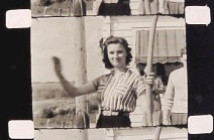UNIDENTIFIED AFRICAN HOME MOVIE
Unknown filmmaker, circa 1955, 16mm, color, silent, 13:27
Location: Tanzania
Shown at Home Movie Day Baltimore
Film transfer by A/V Geeks
Film courtesy of Bob Wagner
Thanks to: Bob & Teresa Wagner, Rich Remsberg
About the film:
This Kodachrome reel was purchased from a film collector with no identifying information. Nothing is known about it, but it is surmised that it was shot by an American traveling or working in eastern Africa. The signs visible in the images are from locations in Tanzania.
These four reels of 16mm Kodachrome home movies were filmed in about 1955 in the former British protectorate of Tanganyika Territory, which is now mainland Tanzania.
The film begins in Tabora, the capital of Tabora Province in western Tanganyika Territory. We see the Fazal Mosque in Tabora, which opened in 1946, and is popularly known as the “Taj Mahal of East Africa.” And the Oriental Sports Club building in Tabora, a social club founded in 1935-36 by Indian immigrants excluded from European social clubs. The film then proceeds to a replica of the “tembe” (rectangular house) where David Livingstone lived from five months in 1872 in nearby Kwihara, including a brief shot of a memorial plaque to Livingstone. There are also several shots of the nearby headstone and grave of John William Shaw, a member of the Stanley Livingstone Expedition who died of malaria in 1871.
The film then returns to Tabora and includes several shots of the historic Orion Tabora Hotel, a railway hotel built in 1914 by a German baron as a hunting lodge. This is followed by a series of shots that filmed around Tabora, including people carrying baskets on their heads, an assortment of domestic animals and birds, and market stalls selling cloth and clothing. There is a sign reading “Marsi Marah, Tailor and Outfitter, Tabora” and “Popailal Kalidas, Gold & Silver Smith.” There are shots of people tilling fields with hand tools, and assorted domestic animals, including goats and cows. There is another shot of the Fazal Mosque. There is a sign reading “Trivedi & Co. Ltd.,” a variety store. Then there are several shots of St. Theresia Catholic Church Tabora Cathedral, followed by shots taken from the top of a small hill overlooking Tabora, and additional shorts of the Orion Tabora Hotel and the Oriental Sports Club, followed by a girl riding a tricycle.
The film then moves to shots from the window of a train traveling through the countryside, followed by shots through the window of a car driving through Moshi, Kilimanjaro Province. There is a sign for “Eros Hotel Bar” painted on the side of a building. Shots of the Moshi Mosque are followed by shots of a small monument consisting of three statues, and more shots of the mosque.
This is followed by series of shots of Arusha National Park, and then by several shots of Momella, the house built by Margarete Trappe at Meru Pass in 1906. Trappe was the first female professional hunter in east Africa. Trappe died in 1957, and her son Rolf sold Momella to the German actor Hardy Krüger. It became the setting of the 1962 movie Hatari!, directed by Howard Hawks and starring John Wayne and Hardy Krüger. Today, the house is part of Hatari Lodge. Margarete Trappe was also a character in “Young Indiana Jones and the Phantom Train of Doom.” A man in a double-breasted suit and a woman in a gingham dress take turns filming each other walking around the grounds of Momella, presumably they are the filmmakers. There are shots taken in the countryside around the house, including the woman sitting next to a stream. There is a shot of a waterfall, then shots of young women carrying bundles of wood by straps across their foreheads.
This is followed by shots of giraffes, then shots of cows being herded along a road. This is followed by shots of a mountain (Meru?), then another, larger lodge with a flower garden, including close-ups of many flowers. This is followed by shots of an open-air market, then shots of wildlife, including gazelle, a baboon, horses, wildebeest, and lions.
This is followed by shots of the New Arusha Hotel in Arusha, Kilimanjaro Province, including a sign outside the hotel reading: THIS SPOT IS EXACTLY HALF WAY BETWEEN THE CAPE AND CAIRO AND THE EXACT CENTER OF KENYA, UGANDA, AND TANGANYIKA.” This is followed by outdoor shots, including shots of Mount Kilimanjaro.
This is followed by shots taken in Mombasa, Kenya, showing the harbor. This is followed by several shots of car, and a shot of people playing either cricket or soccer. This is followed by shots of boats in the harbor. This is followed by shots of Fort Jesus on Mombasa Island, which was built between 1593 and 1596 by order of King Philip I of Portugal to guard the Old Port of Mombasa.
The filming style is often quite staccato, featuring short bursts of images, with fluctuating exposure. In some respects it is reminiscent of the camerawork of Jonas Mekas.
–Brian L. Frye

